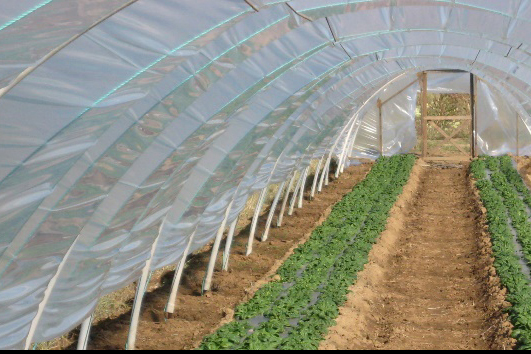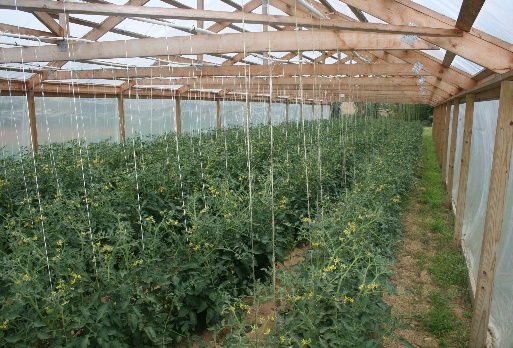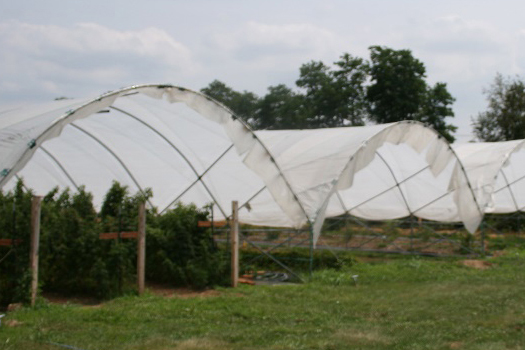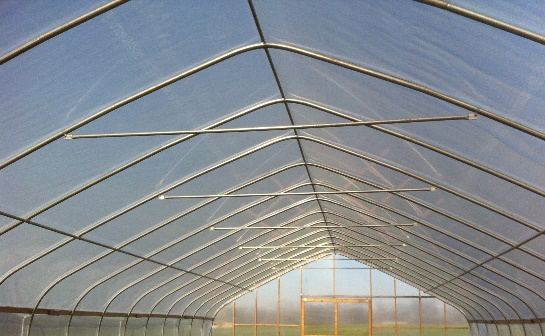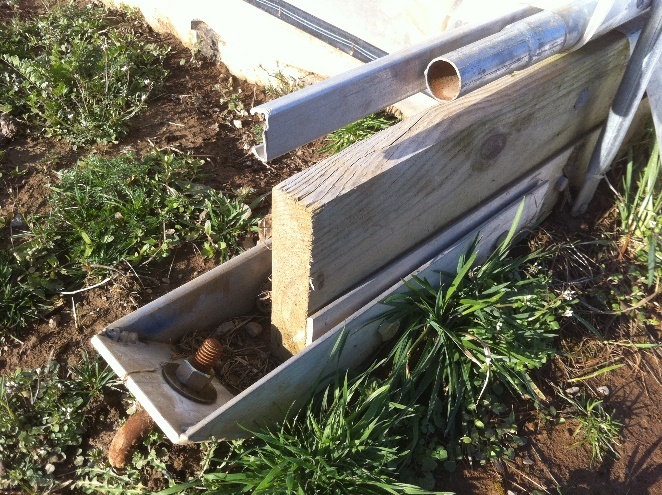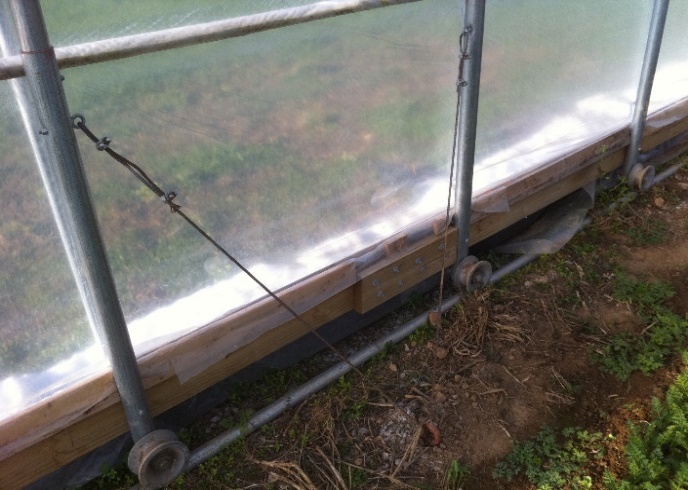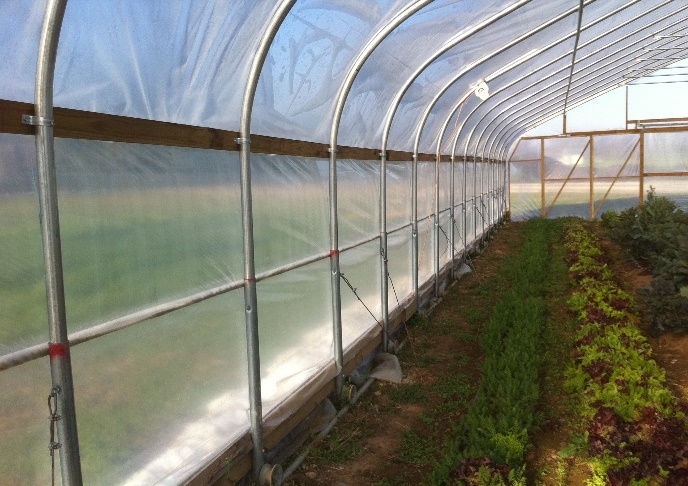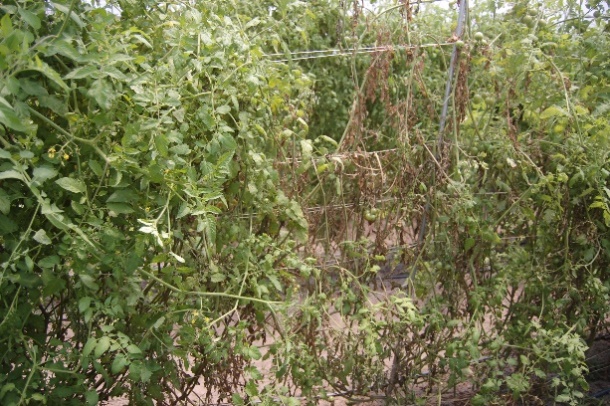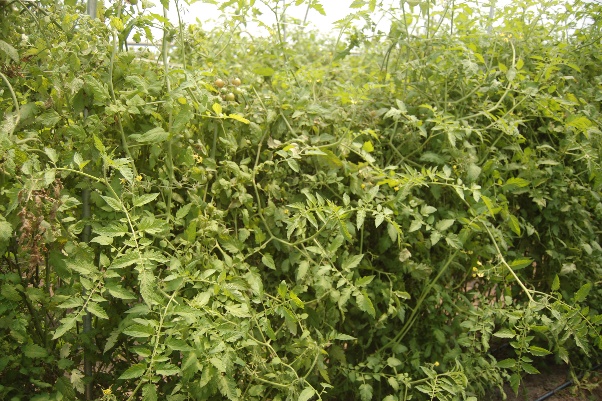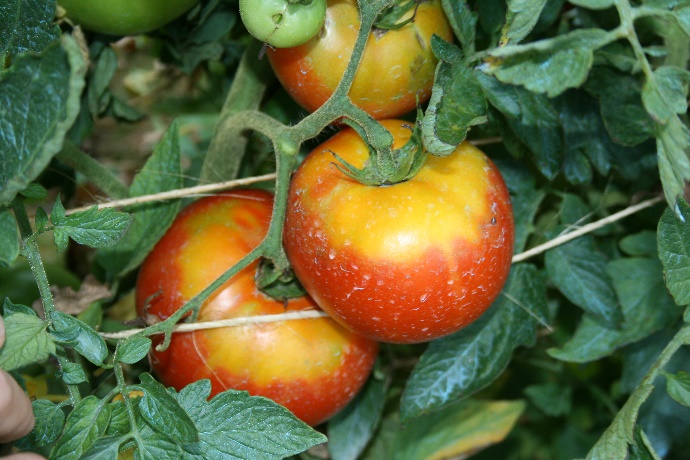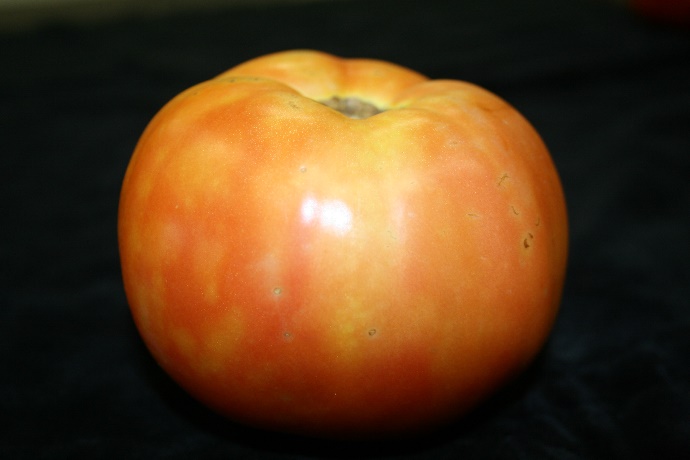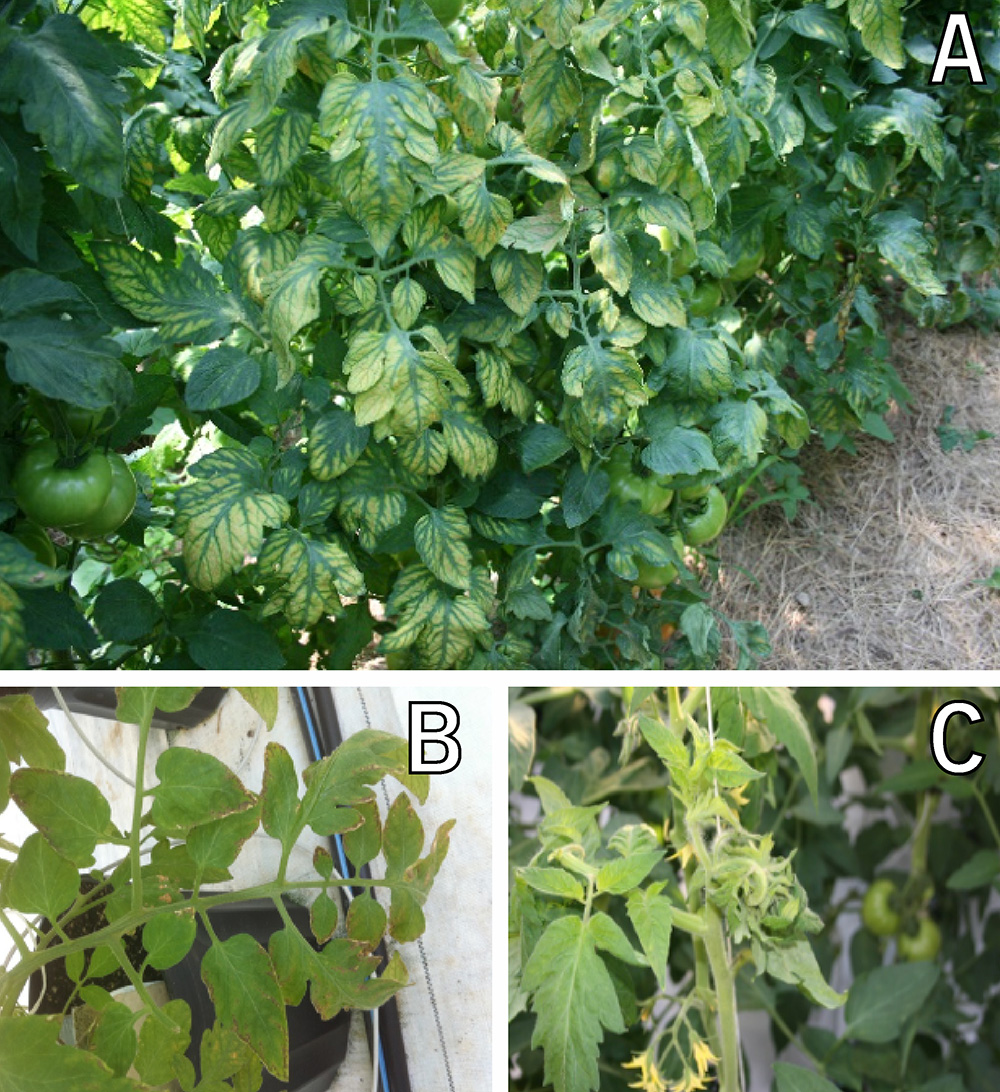Additional contributing authors: Xin Zhao, professor, University of Florida Department of Horticulture Sciences.
- Usage
- Structures and Siting
- Ventilation and Cooling
- Planting, Pruning, and Trellacing
- Grafting
- Soils and Fertility
- Irrigation Management
- Pollination
- Tomato Disorders
- References
- Additional Resources
Usage
High tunnels are passively ventilated and heated structures that farmers use to extend a tender crop's growing season outside the normal window for production. Emery Emmert, a professor of horticulture at the University of Kentucky, generally is credited with developing the concept of the unheated, plastic-covered greenhouse in the 1950s. While they gained significant traction in Europe and Asia, their use in the United States was limited for many years. By the turn of the 21st century, Asia and the Mediterranean regions had more than 1.3 million acres of plastic greenhouses and high tunnels in production (Papadopoulos & Demers, 2003). High tunnels gained traction in the United States from the 1980s onward, as growers in more northern climates sought to extend their market windows. In a 2007 survey, Maine and Vermont were estimated to have approximately 700–1000 and 500 tunnels, respectively (Carey et al., 2009). That same survey reported roughly an acre of high tunnel production in Georgia at the time, with Florida reporting between 50–100 total acres. Throughout the 2000s, high-tunnel usage steadily increased throughout the United States, aided by the growth of small farms offering fruits vegetables for local sales, as well as programs such as the USDA Natural Resource Conservation Service (NRCS) Environmental Quality Incentive Program (EQIP). Between 2010–2020, NRCS helped fund more than 26,000 high tunnels across the United States (K. Jacobsen, personal communication).
Structures and Siting
High tunnels can come in many forms, such as simple homemade structures made inexpensively with PVC, stand-alone metal-framed unheated greenhouses, large multibay complexes, and nearly everything in between (Figure 1). While most tunnels are made from galvanized steel, there also are wooden-framed structures. Because wooden trusses may have a larger surface area than a comparable steel bow, growers should be cautious that wooden structures don't cause too much shading over the plants. Organic growers should be aware that treated lumber may not be used for baseboards or any part of the structure that contacts the soil in high tunnels where crops are grown in the ground (Taylor et al., 2013). While it's possible to encase the treated lumber to ensure that it has no contact with the soil, growers typically utilize nontreated woods or steel instead.
Anchoring your high tunnel also is an important consideration. Some tunnel kits come with sidewall posts that have augured bases that act as anchors in the soil, while others are simply steel pipes driven into the soil. In areas with sandy or shallow soils, or if the site is exposed to high winds, ground posts may be anchored with concrete. High tunnels have a large surface area and can act as a wing when subjected to high winds. The amount of uplift on a high tunnel can be substantial and producers should think through how their structures will be anchored (Figure 2).
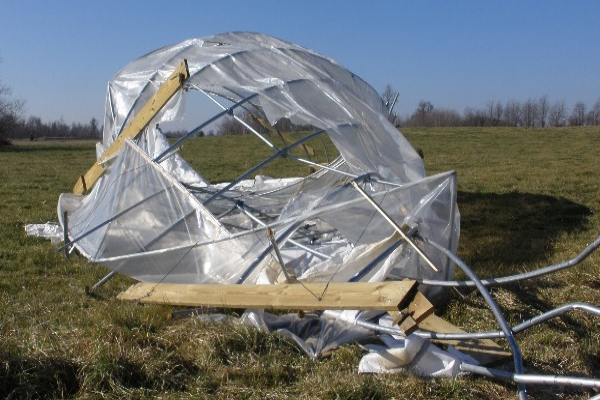
Though most high tunnels are stationary, there are several options for growers that utilize movable tunnels (Figure 3), which can allow for improved crop rotation. The intensive year-round production in tunnel structures can lead to increased soilborne pathogens such as nematodes and diseases such as southern blight, caused by the soilborne fungus Sclerotium rolfsii, or white mold, caused by Sclerotinia sclerotiorum. Movable tunnels may be anchored using portable tree/vineyard anchors or similar. Another advantage of movable tunnels is that a crop may be started outdoors in late summer and then a tunnel can be moved over the crop when temperatures drop. This avoids exposing the young plants to high temperatures often encountered in tunnels in the late summer.
High tunnels can be covered with one or two layers of plastic. When two layers of plastic are used, an inflation fan is often needed to create the air space between the layers of plastic. This air space provides extra insulation and can help trap heat during the winter months. In the north Georgia mountains this extra insulation can be helpful, but it isn't typically required throughout the rest of Georgia and Florida. Plastics for high tunnels are typically 4 to 6 mil thick. While the 6-mil plastic often has an expected life span of 4 years, keep in mind that there are many variations on plastics. Infrared (IR) plastics hold heat better than others, while some plastics are made with anticondensate, which reduces dripping onto the crop below. Woven plastics are heavyweight (9 to 12 mil) coverings with longer life spans that are built to withstand extreme weather events, such as hail. Growers should consider washing or cleaning plastic annually because dirt and dust can build up, leading to significant shading. Measurements taken in tunnels with old and dirty plastic showed a 20%–30% reduction in light intensity compared to ambient conditions (Figure 4).
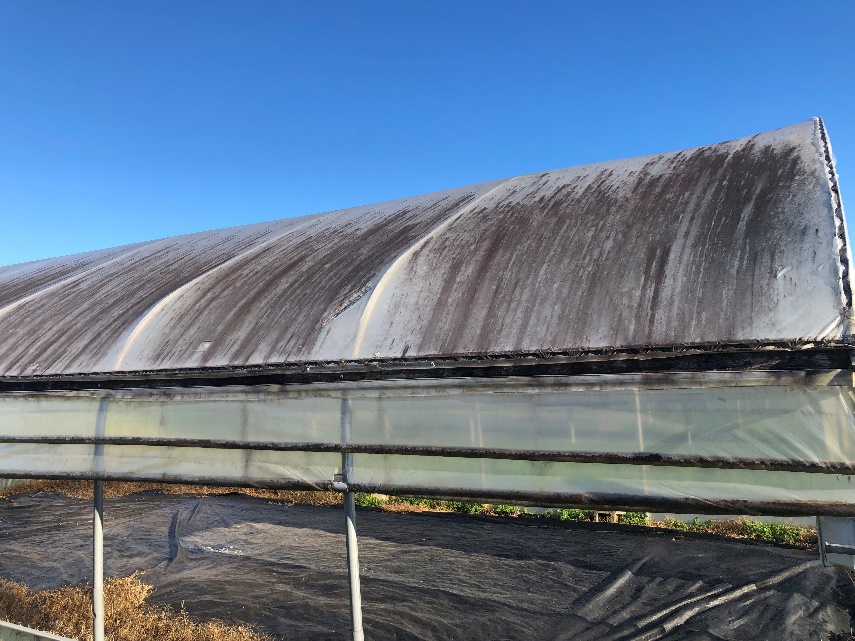
Siting a high tunnel is also an important consideration. While many growers must make do with space limitations, high tunnels ideally should be located on a north–south orientation to reduce shaded areas in the tunnel. If you plan to expand over time, with multiple tunnels adjacent to each other, a north–south orientation is even more critical. If adjacent tunnels are oriented parallel and east to west, the southernmost tunnel will shade tunnels located north of it. While this is less noticeable during midsummer when the sun is highest above the horizon, the effects are quite pronounced during winter months when the sun remains lower to the horizon. If movable tunnels are a consideration, growers must also account for the extra room needed to move the tunnel.
Ventilation and Cooling
While growers in cold climates often focus heavily on the temperature protection from cold weather that high tunnels offer, in warm weather states such as Georgia and Florida adequate ventilation of high tunnels is critical. Our farm trials have shown 3 to 10 °F increases in nighttime low temperatures in high tunnels depending on the type and quality of the tunnel. Daytime temperatures in the summer in those same tunnels often can exceed 125 °F. Even in cold-weather months during clear sunny days, high tunnel temperatures can easily exceed outside temperatures by 40 °F or more. During warmer months, temperatures in poorly vented tunnels easily can kill crops.
Sidewalls that roll up or down are essential for high-tunnel growers in the southeastern U.S. Growers may also use ridge vents in tunnels to provide maximum cooling, though the additional costs associated with the vents may be more than many can afford. Because high tunnels typically are passively ventilated (no fans), evaporative cooling systems generally are not employed. Studies conducted at UGA evaluating the efficacy of misting/fogging to reduce temperatures in high tunnels suggested that without active ventilation, the cooling effects of fogging systems were negligible while also leading to higher humidity and soil-moisture levels (Laur et al., 2021). Although commonly employed in greenhouses, evaporative cooling methods may be less effective in high tunnel structures. Excessive moisture in the soil coupled with little air movement also can cause significant fog and condensation inside tunnels, which can lead to disease (Figure 5).
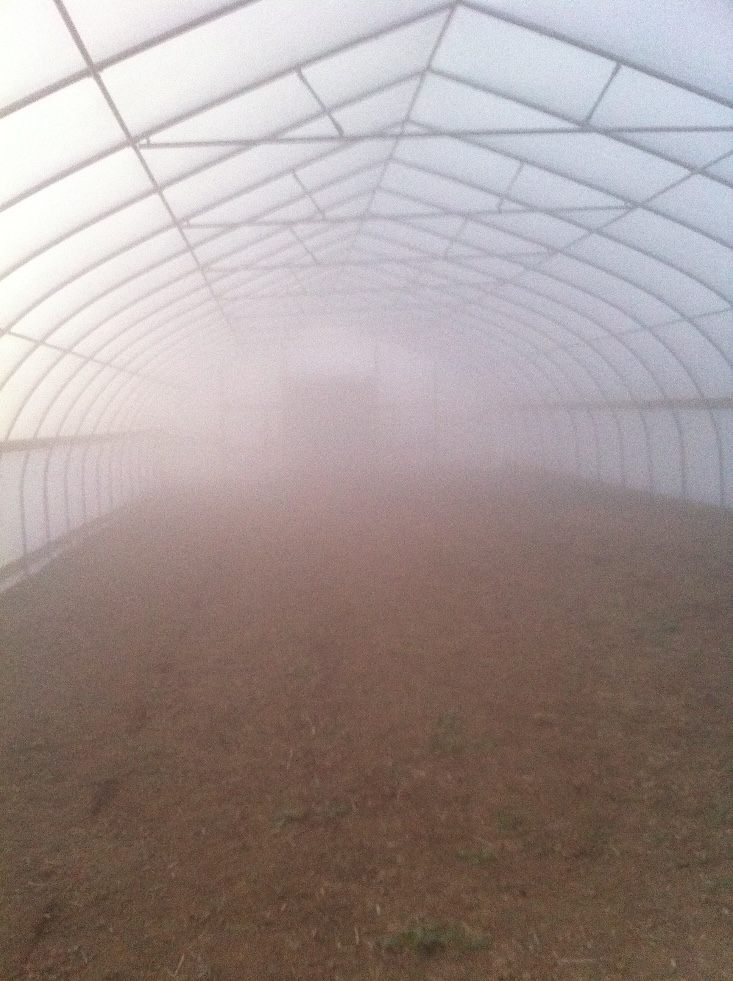
The type of high tunnel structure also can result in improved or reduced air flow during warm periods of the year. Tunnels with static end walls and low sides may hinder air movement compared to those that have large open ends with high peaks. Shade cloth is routinely used for high tunnel production in the southeastern U.S. Research conducted at UGA suggests that 30%–50% shading is appropriate for production of crops from late spring to early fall in high tunnels in Georgia. While black shade cloth has traditionally been used by growers, silver-reflective shade cloth results in a greater reduction in temperatures because it reflects more light (Hohenstein, 2012). Growers in some situations use other colors of shade cloth, including red and green, but black and silver are the most common.
Because of the prevalence of insect pests and their ability to serve as virus vectors in crops such as tomatoes, some growers use insect netting over side and end walls. Research conducted at Florida A&M University, Auburn University, and the USDA utilizing tunnels covered only with insect netting have shown promising results. While some insects inevitably make it into the tunnels, the netting can reduce insect pressure and allow for the use of organic products or predatory insects for control of some insect pests in high tunnels. In semitropical environments, insect netting may allow for cooler temperatures compared to only using plastic-covered tunnel structures.
Planting, Pruning, and Trellising
One of the biggest decisions that growers will need to make regarding organic tomato production in high tunnels is what type of tomato will be grown—indeterminate or determinate—and the spacing of these plants. While most high tunnel tomato growers choose a closer spacing than in the field to maximize profit potential and yields, the type of tomato production system can significantly influence spacing. In general, when growing indeterminate varieties that are recommended for greenhouse production using a trellis system, plants can be spaced closer together as they usually are pruned to one or two central leaders (Figure 6). Researchers at UGA have grown multiple successful crops of organic indeterminate tomatoes pruned to a single leader with between-row spacing of 4 ft and within-row spacing of 18 in. This equates to roughly 6 square feet per plant. Conventional greenhouse hydroponic tomatoes may be grown using tighter spacing (4 square feet per plant), but keep in mind that this production system often has greater air movement and nutrient availability. As plants in a trellis system become tall and reaching a trellis wire, air flow can dramatically decrease within the tunnel (Fatnassi et al., 2009).
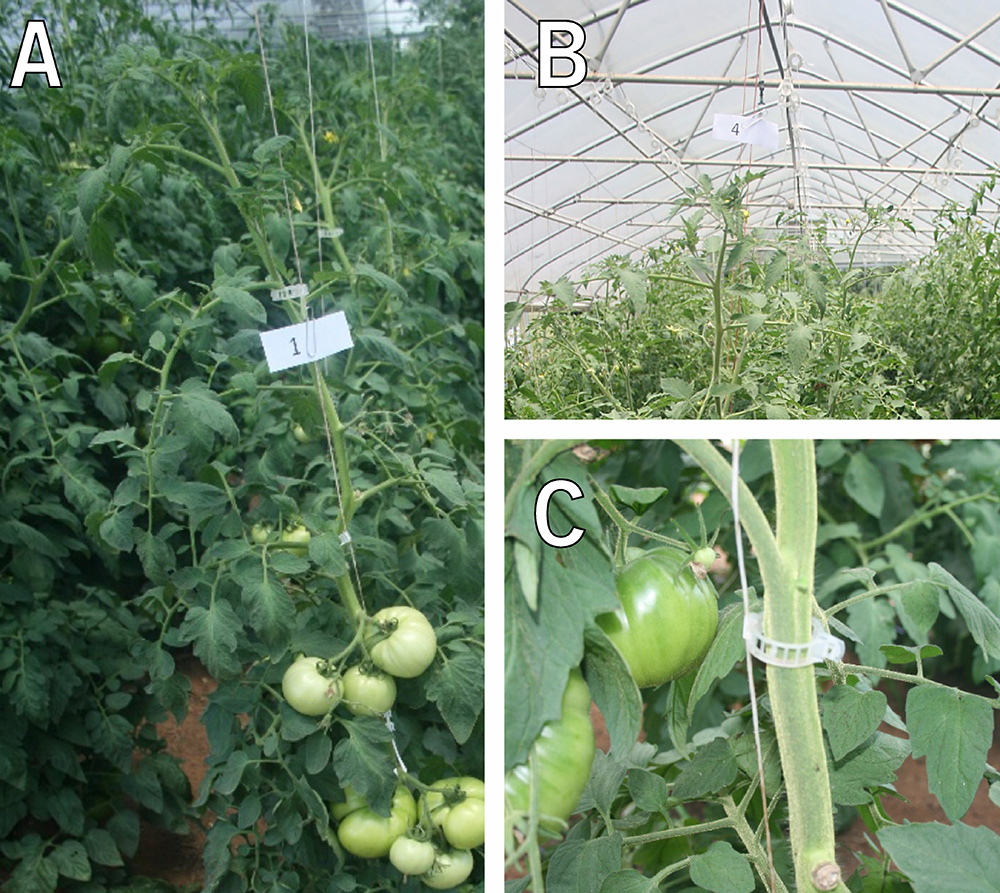
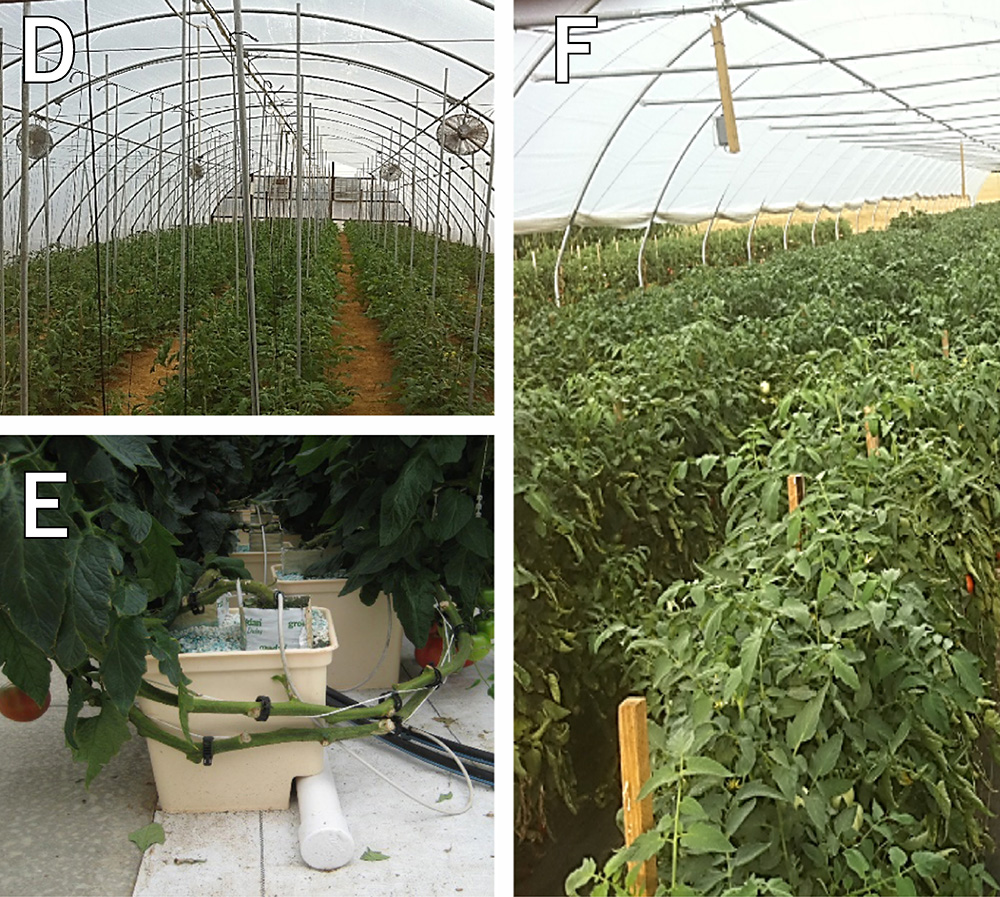
Indeterminate tomato plants grown using a trellis system are often “laid down” in a traditional hydroponic production system (Figure 6). However, this method of production requires significant labor to manage plants as well as a commitment to keep a plant in production for long periods of time (10 months or more). Because of the summer heat in high tunnels in Georgia and Florida, growers may find it better to “top” plants when they reach a certain height, usually the height of the support wire in the tunnel. This reduces labor requirements and moves production out of the tunnel and into the field for the hottest summer months.
Growers may also choose to grow indeterminate tomatoes in high tunnels using a traditional stake-and-weave method, similar to what is used in field production. This method requires less initial infrastructure than a trellis system with strings and hooks but will require frequent stringing to keep plants upright.
High tunnel producers may also choose to plant field-type determinate tomatoes. Because these plants may only have a few suckers removed near the bottom of the plant they tend to be bushier than indeterminate varieties pruned to a central leader. Determinate varieties shouldn't be pruned to a central leader as their yields will suffer since they are not meant for this type of production. Because of the bushier habit of determinate tomatoes, they may need to be spaced further apart. Trials and on-farm observations suggest a spacing of 7.5 to 9 square feet per plant for these types of tomatoes in high tunnels. Research conducted at UGA indicated that for a short spring season (March–July), determinate tomatoes had comparable yields to indeterminate types per 100 row feet. However, because of a concentrated fruit set, harvests of the determinate types took place over a much shorter period (four harvests for determinate vs. nine for indeterminate). Nonetheless, labor was significantly less because the determinate types were staked and strung using a Florida weave system, which requires less effort than a vertical trellis. Determinate tomatoes may be a better option for growers simply looking to extend their market a few weeks on either side of the field season. Indeterminate varieties may be a better choice for growers looking for longer production periods in the tunnel and a greater variety of specialty type fruit than usually are available (Figure 7).
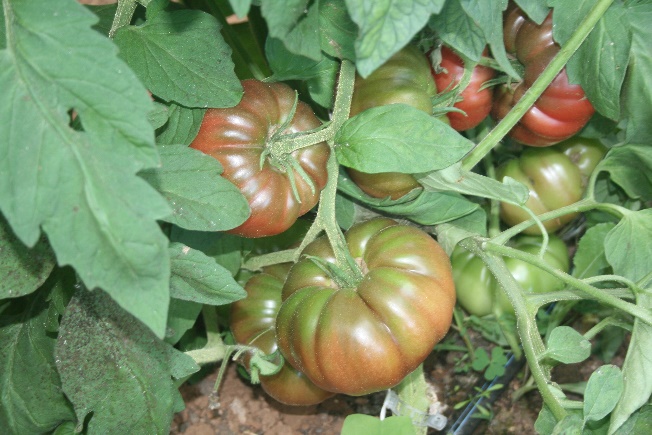 Figure 7. Indeterminate tomatoes often provide more specialty types of fruit.
Figure 7. Indeterminate tomatoes often provide more specialty types of fruit.Planting dates will vary widely with the type of structure used and the location within Georgia and Florida, which covers a distance of nearly 700 miles north to south. While some single-layer tunnels may only provide 2–3 °F of cold-temperature protection, on particularly cold nights an additional layer of row cover can be provided to protect plants. On-farm data shows that this cover within a tunnel can provide another 2–3 °F of protection. In southern Florida, where temperatures rarely dip below freezing, high tunnels may be used to provide a greater accumulation of growing degree units during the day and reduce rainfall on plants. First planting dates for tomatoes in Georgia in the field range from March 1 in southern Georgia to April 15 in north Georgia. In most well-constructed high tunnels, growers should be able to plant at least 1 month earlier than in the field.
Light levels also impact tomato planting. This is much more pronounced in the fall than in the spring. Tomatoes need adequate light to set fruit. While light levels remain high through September, average daily solar radiation drops to 50% of peak summer levels by November in central Georgia (Dunlap et al., 1994). While temperatures may remain adequate for tomato plant growth, light levels in late fall drop enough to significantly reduce fruit set. Because of this many growers have decided to focus on high tunnel tomatoes in spring, when light levels rapidly increase from February to April, and plant leafy greens crops that require lower light levels in the fall.
Grafting
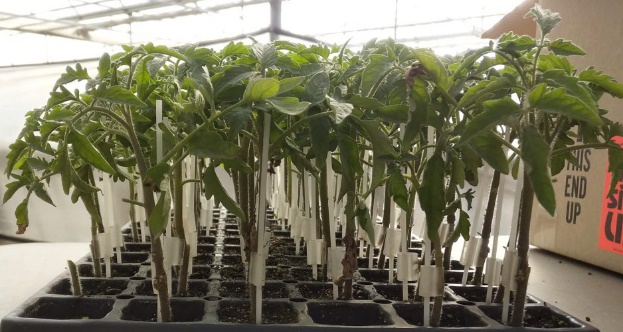 Figure 8. Grafted tomato transplants at the nursery ready to ship to growers.
Figure 8. Grafted tomato transplants at the nursery ready to ship to growers.Vegetable grafting is a technique that is widely used around the world (King et al., 2008). Use of rootstocks with resistance to soilborne diseases, including root-knot nematodes, effectively has managed these plant pathogens in high-tunnel-grown tomatoes (Frey et al., 2020; Rivard et al., 2010; Thies, 2021). While breeding a variety with high levels of disease resistance and high-quality fruit may take many years—if ever—grafting can significantly shorten this process by physically uniting two genotypes (i.e., scion and rootstock) to integrate desirable above- and belowground traits in a new plant (Figure 8). Because of restrictions on using chemical pesticides in organic production, grafting is an even more important tool for organic farmers (Figure 9). In addition to disease resistance, grafting with selected rootstocks also can increase the vigor of plants in some cases and help improve nutrient and water-use efficiency.
In high tunnel organic tomato production, improved crop growth, yield, and extended harvests may be achieved by combining rootstocks that have soilborne disease resistance and other beneficial root characteristics with tomato scions that lack resistance to soilborne pathogens but possess desirable fruit attributes and resistance to foliar disease. Since grafted transplants are more expensive than regular tomato seedlings, rootstock selection is critical to the cost-effective use of grafting to maximize benefits. Disease problems need to be clearly identified in order to choose the appropriate rootstock, and rootstock-scion interactions need to be considered to minimize potential negative impact on fruit quality. In addition, cultural and management practices (e.g., plant spacing, pruning and trellising, fertilization) may need to be adjusted to balance and optimize growth and development of grafted tomato plants. This is especially true when highly vigorous rootstocks are used to prevent significant delays in early harvest. You can get more information from this research-based resource on grafting: http://www.vegetablegrafting.org/resources/grafting-manual/.
Soils and Fertility
While conventional tomato production in high tunnels uses synthetic fertilizers, organic production may take more planning because of the need to provide nutrients from a variety of sources. Compost, which is widely used to increase soil organic matter and provide supplemental fertility in organic operations, can easily be overused in high tunnel operations because of the small area covered by a single tunnel (roughly 1/20 of an acre for a 30-ft x 72-ft tunnel). Applying too much compost can lead to long-term imbalances in some soil nutrients. Keep in mind that even applications of 10 tons of compost per acre appears as a light dusting in open fields. Several inches of compost applied in a high tunnel would equate to exceptionally high rates of compost if applied in the field. Overapplication of composts or other soil amendments can lead to salt imbalances in high tunnels (Coolong et al., 2020).
The soil test in Table 1 is from a long-term organically managed tunnel that has received large amounts of compost and poultry litter over several years, resulting in very high levels of plant nutrients. Because high tunnels receive no rain, there's relatively little (if any) leaching of fertilizer salts from the soil. While this may be more problematic for conventional growers using large amounts of synthetic fertilizers with high salt indices, organic growers also should be aware of the impact of this on their systems.

Since high tunnel space is valuable, cover cropping is less common than in the field. However, both summer and winter cover crops can provide a host of benefits for high tunnel producers. There are several good publications for cool- and warm-season cover crops available for the southern U.S. (see the Additional Resources section). When choosing a cover crop for a tunnel you will need to consider the rate of breakdown of the cover crop in a relatively dry environment. A large biomass-producing cover crop with a high C:N ratio such as a sorghum x sudan grass hybrid may not be the best choice for a high tunnel as it will take time to break down and could potentially tie up plant-available nitrogen. Conversely a legume cover crop such as crimson clover (Figure 10) can fix nitrogen for the soil, has a low C:N ratio, and will break down quickly when terminated. However, there are no perfect cover crops in high tunnels since legumes (such as clover) also can serve as a host for nematodes, negatively impacting the cash crop in the tunnel. When seeding cover crops in a tunnel you likely will need to supply overhead irrigation to ensure uniform germination and coverage throughout. Many high tunnels are not set up for overhead irrigation, but a simple sprinkler or orchard tubing with emitters/misters attached to the bows can suffice.
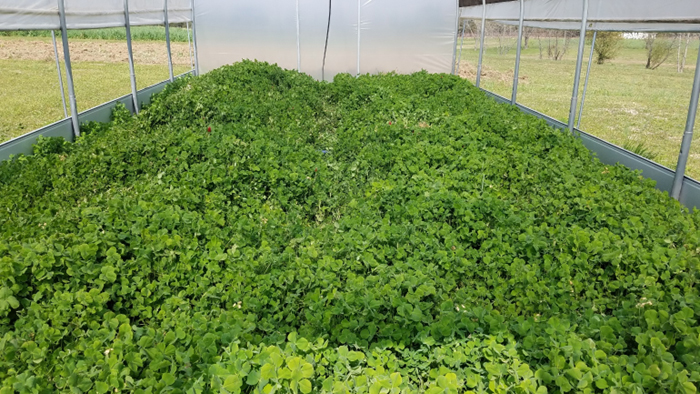
The University of Georgia recommends 100–150 lb/acre nitrogen for field tomatoes grown in the piedmont and mountains (heavy soils) and 150–200 lb/acre nitrogen for tomatoes grown in the sandy coastal plain. The University of Florida recommends 200 lb/acre nitrogen for field tomatoes. Converting recommendations from the field to high tunnels can be challenging. Both Georgia and Florida use the linear row-feet method of calculating fertilizer applications, which makes conversion of field values to high tunnels a bit easier. Field recommendations in Georgia assume that rows are spaced on 6-ft centers, which would allow for 7,260 row-feet per acre (not including rows for spraying or driving). Tomatoes in the field typically are planted 22–24 in. apart for a rough population of 3,630 to 3,967 plants per acre. Because high tunnel plantings may be at different spacings, growers can estimate how much fertilizer to apply per row based on plant populations. If you have 50 tomato plants in a row you can estimate your nitrogen requirements using the following formula:
50 (plants per row) ÷ 3,630 (average plants per acre) = 0.0138
Using 150 lb/acre nitrogen x 0.0138 = 2.07 lb of nitrogen per row
Current recommendations are for field-type determinate tomatoes, so if you grow a longer-season indeterminate tomato you may require additional nitrogen. In addition, high tunnel tomatoes often are more productive per unit of area than their field counterparts, which may further increase their fertility requirements. However, soils that have been managed for several years using organic practices may have significant nitrogen contributions from organic matter. UGA Extension has a publication that discusses the contribution of cover crops to plant-available nitrogen, as well as a calculator that can help predict plant-available nitrogen: B 1466 Predicting Nitrogen Release from Cover Crops.
When using commercial organic fertilizers, growers should be aware of the mineralization rates of different products. Mineralization is driven by soil biology and is sensitive both to temperature and soil water content. When organic fertilizers are broadcast throughout high tunnels, areas between rows often remain dry throughout the growing season—particularly when using a single drip line (Figure 11). Fertilizer in these regions will undergo relatively less mineralization than fertilizer applied in-row.

Research is still needed, but we assume that much of the phosphorus and potassium from organic fertilizers becomes plant-available over time. Rock phosphate and mined potassium sources (i.e., potassium sulfate) are NOP certified and can provide both phosphorus and potassium when soil tests indicate deficiencies. The mineralization of nitrogen from organic fertilizers, on the other hand, can be highly variable depending on the product and environmental conditions. Products like feather meal, blood meal, or fish meal (or emulsion) rapidly mineralize, beginning the first week after application. About 70% of total nitrogen applied may ultimately become available. Mixed products and pelleted poultry fertilizers have a longer release rate over 3–4 weeks and the amount of nitrogen available can vary from 30% to 70% of total nitrogen applied. Chilean nitrate (also known as sodium nitrate) is the only inorganic nitrogen fertilizer allowed in organic production and immediately supplies plant-available nitrogen. However, Chilean nitrate in organic production is restricted and its allowance can vary (depending on your certifier), so growers should check with their certifiers prior to applying Chilean nitrate. Slower-release fertilizers (mixes/pelleted poultry litter) may be good nitrogen sources at planting time while faster-release sources (fish emulsion, blood, or feather meal) can help when nitrogen deficiency is observed.
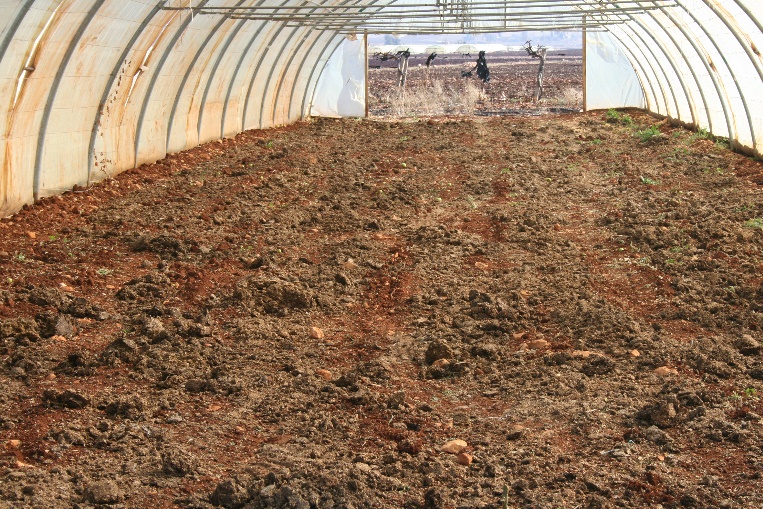
Litter that is left on the soil surface (Figure 12) loses nitrogen through ammonium volatilization and should be incorporated into the soil soon after application. Growers also should follow national organic program guidelines for the application of manures, which require a preharvest interval of 120 or 90 days from manure application, depending on whether your harvested crop contacts the ground.
Irrigation Management
Nearly all high tunnel tomatoes are grown using drip irrigation. Because of the lack of rain in a high tunnel environment, irrigation needs may be considerably more than in a field. Generally in a high tunnel you are wetting only a relatively narrow bedded area adjacent to the plants. The flow rate of your drip tape will be important in determining how long to run irrigation. Table 2 shows run times for different flow rates of drip tape to supply 1 in. of water to a given bed width. It is better to provide frequent (daily) irrigation for shorter periods of time to maintain relatively constant soil moisture levels compared to infrequent, long irrigations. This should reduce cracking of fruit as well as the risk of disorders such as blossom end rot.
| Drip Tape Flow Rate | Wetted Width | ||
|---|---|---|---|
| 2 ft | 2.5 ft | 3 ft | |
| Gallons/min per 100 ft | time in hr | ||
| 0.22 | 9.4 | 11.8 | 14.2 |
| 0.30 | 6.9 | 8.7 | 10.4 |
| 0.34 | 6.1 | 7.6 | 9.2 |
| 0.45 | 4.6 | 5.8 | 6.9 |
| Note. Adapted from Table 6-2 in “High Tunnel Farming,” by S. Gu, 2021, NC A&T Cooperative Extension Bulletin AN21-01, p. 43 (https://online.fliphtml5.com/nbdy/vsse/#p=1). Copyright 2021 NC A&T Cooperative Extension. | |||
Pollination
Tomatoes typically are self-pollinated and may require some movement of the flower to stimulate pollination. When they are grown in the field, the air movement over plants is generally enough to vibrate the flowers, leading to pollination. In commercial greenhouses, pollination is assisted using bees (Figure 13), handheld vibrating pollinators, or even leaf blowers. In high tunnels, pollination is not typically an issue when the sidewalls are open and air movement is adequate. However, when producing tomatoes during the coldest months of the year, sidewalls may remain closed for extended periods of time, which reduces airflow and may impact pollination. Growers can combat this through using any of the methods listed above. When using bees, take care to ensure that there are not too many bees for the number of plants in the tunnel. When there are too many bees, the excessive flower visits can result in damage to flowers and flower or fruit abortion.
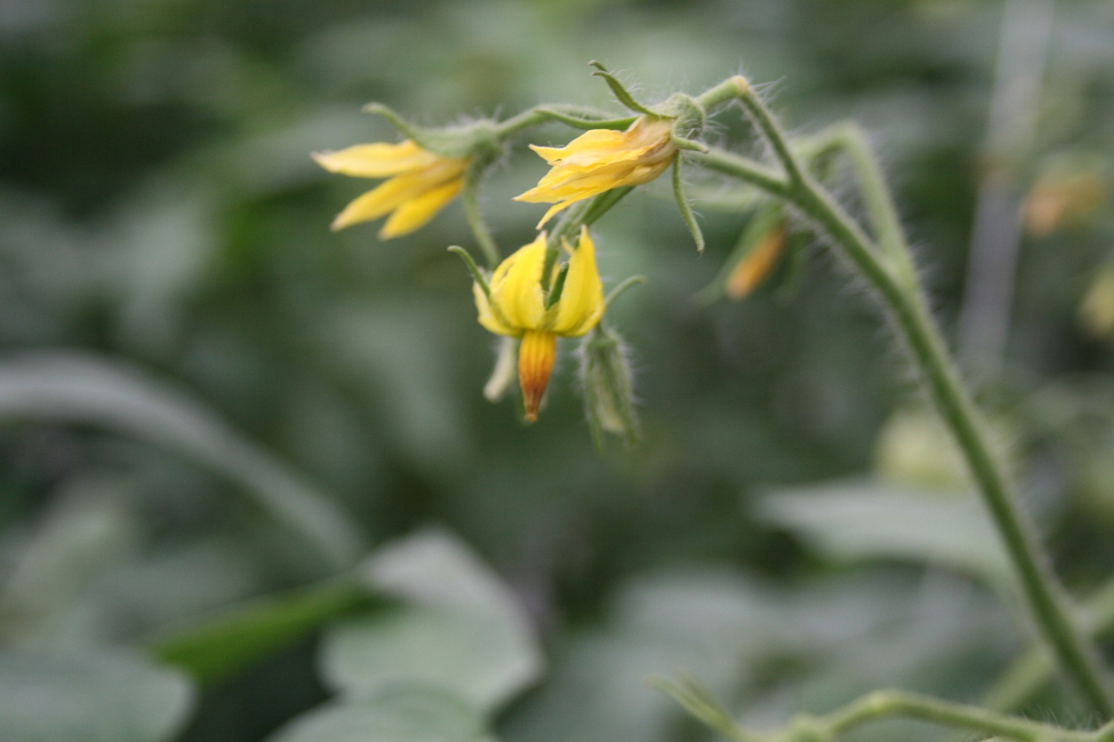
Temperatures also can impact tomato pollination. Optimum temperatures for pollination are between 68 and 75 °F; however, pollination can occur when night temperatures remain between 55 and 75 °F and daytime temperatures are between 60 and 90 °F (Jones, 2007). Temperatures in late winter can routinely fall below these ranges at night, which can negatively impact both fruit set and the likelihood of pollination-related disorders in fruit. Similarly, in late spring and early summer, high temperatures during the daytime can also result in a lack of fruit set and yield loss.
Tomato Disorders
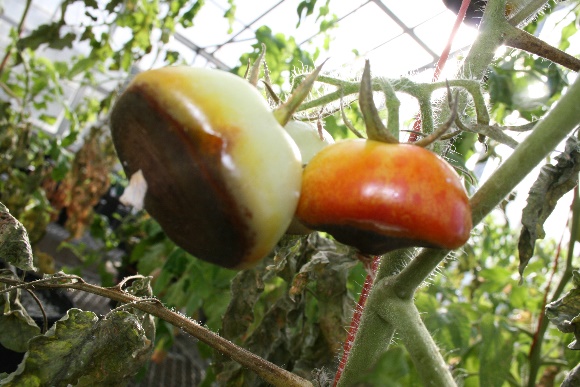
Blossom end rot (Figure 14) is the most common of all tomato disorders. Although historically linked to a calcium deficiency during early fruit development, many environmental factors—such as humidity, soil moisture availability, and temperature—can influence the movement of calcium into the plant and can affect the incidence of blossom end rot. Some varieties also are particularly prone to this disorder.
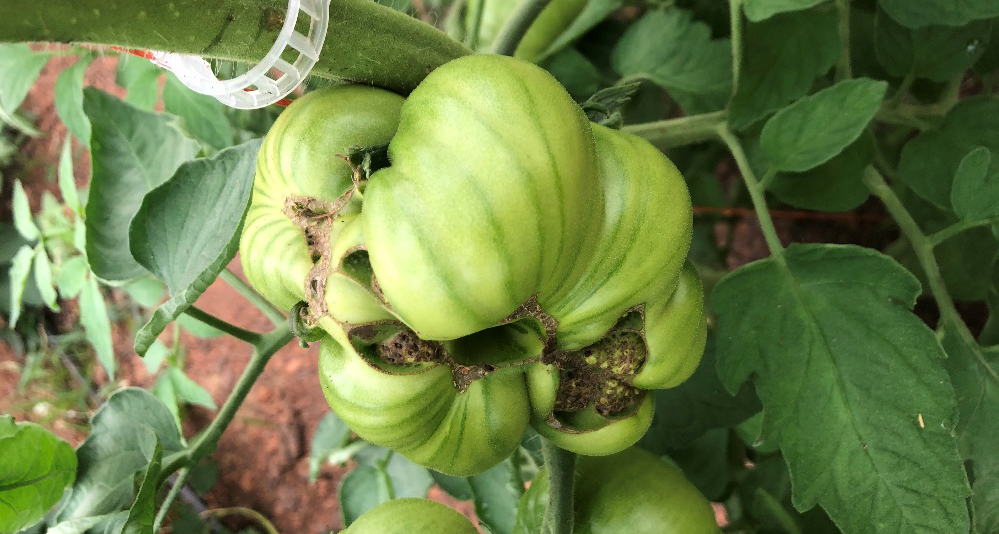
Catfacing (Figure 15) can result from poor pollination because of a variety of environmental factors. Some heirloom tomatoes, particularly larger-fruited types, are especially prone to catfacing. Poor pollination can also result in undeveloped locules in fruit.
Cracking. Radial cracking will occur from the stem attachment outward, which often is the result of excessive water during ripening. Concentric cracking results from water sitting on the shoulders of fruit.

White core (Figure 16) can occur as the result of low potassium as well as excessively high temperatures during fruit development, which can occur in high tunnels in late spring and summer in the southeastern U.S. Some varieties are more susceptible than others.
Ripening disorders (Figure 17) include yellow shoulder (bottom left) and blotchy ripening (bottom right). Some varieties are more susceptible to these disorders and many heirloom tomatoes do not ripen uniformly, resulting in yellow shoulder. Other causes of ripening disorders include low potassium, cool cloudy weather, and virus infection (ToMV and TMV). Keep in mind that if the plant is infected with a virus the symptoms should occur on both fruit and foliage.
Nutrient deficiencies (Figure 18) are routinely encountered in high tunnel tomato production. Magnesium deficiency will appear as interveinal chlorosis on older leaves, particularly after the second or third cluster of fruit is set. Epsom salts can be approved for organic production and may be used to correct magnesium deficiencies in tomatoes. Potassium deficiency also will appear on older foliage and the leaves may show signs of interveinal chlorosis—less pronounced than with magnesium deficiency—and also marginal necrosis on leaves. Potassium sulfate is also approved for organic use and is a soluble source of potassium for high tunnels. Excessive nitrogen can sometimes appear as distorted (twisted) growth and fruit abortion, particularly during cool and cloudy weather when growth slows.
References
Carey, E. E., Jett, L., Lamont W. J., Jr., Nennici, T. T., Orzolek, M. D., & Williams, K. A. (2009). Horticultural crop production in high tunnels in the United States: A snapshot. HortTechnology, 19(1), 37–43. http://dx.doi.org/10.21273/HORTSCI.19.1.37
Coolong, T., Gaskin, J., Haramoto, E., Jacobsen, K., Moore, J., Phillips, T., Rudolph, R., & Wszelaki, A. (2020). Covers under cover: Managing cover crops in high tunnels (Publication No. CCD-SP-16). University of Kentucky Cooperative Extension Service Center for Crop Diversification. https://www.uky.edu/ccd/sites/www.uky.edu.ccd/files/CoversUnderCover1.pdf
Dunlap, M. A., Marion, W., & Wilcox, S. (1994). Solar radiation data manual for flat-plate and concentrating collectors. U.S. Department of Energy National Renewable Energy Laboratory. https://doi.org/10.2172/10169141
Fatnassi, H., Leyronas, C., Boulard, T., Bardin, M., & Nicot, P. (2009). Dependence of greenhouse tunnel ventilation on wind direction and crop height. Biosystems Eng., 103(3), 338–3430. https://doi.org/10.1016/j.biosystemseng.2009.03.005
Frey, C. J., Zhao, X., Brecht, J. K., Huff, D. M., & Black, Z. E. (2020). High tunnel and grafting effects on organic tomato plant disease severity and root-knot nematode infestation in a subtropical climate with sandy soils. HortScience, 55(1), 46–54. https://doi.org/10.21273/HORTSCI14166-19
Hohenstein, J. A. (2012, May 21). Black shade cloth versus reflective screens. Greenhouse Grower. https://www.greenhousegrower.com/technology/equipment/black-shade-cloth-versus-reflective-screens
Jones, J. B., Jr. (2007). Tomato plant culture: In the field, greenhouse, and home garden (2nd ed.). CRC Press. https://doi.org/10.1201/9781420007398
King, S. R., Davis, A. R., Liu, W., & Levi, A. (2008). Grafting for disease resistance. HortScience, 43(6), 1673–1676. https://doi.org/10.21273/HORTSCI.43.6.1673
Kubota, C., Miles, C., & Zhao, X. (Eds). (2017). Grafting Manual: How to produce grafted vegetable plants. USDA-SCRI Vegetable Grafting Project. http://www.vegetablegrafting.org/resources/grafting-manual/
Laur, S., da Silva, A. L. B. R., Diaz-Perez, J. C., & Coolong, T. (2021). Impact of shade and fogging on high tunnel production and mineral content of organically grown lettuce, basil, and arugula in Georgia. Agriculture, 11(7), 625. https://doi.org/10.3390/agriculture11070625
Papadopoulos, A., & Demers, D. (2003). Greenhouse horticulture. In S. H. Katz & W. W. Weaver (Eds.), Encyclopedia of food and culture. Scribner.
Rivard, C. L., O'Connell, S., Peet, M. M., & Louws, F. J. (2010). Grafting tomato with interspecific rootstock to manage disease caused by Sclerotium rolfsii and Southern root-knot nematode. Plant. Dis., 94(8), 1015–1021. https://doi.org/10.1094/PDIS-94-8-1015
Taylor, A., Klingman, W., Wszelaki, A., Saywell, D., & Amundson, S. (2013). Treated wood on organic farms (Bulletin W 235-H). University of Tennessee Institute of Agriculture. https://extension.tennessee.edu/publications/Documents/W235-H.pdf
Theis, J. A. (2021). Grafting for managing vegetable crop pests.Pest Mgmt. Sci., 77(11), 4825–4835. https://doi.org/10.1002/ps.6512
Additional Resources
Coolong, T., Gaskin, J., Haramoto, E., Jacobsen, K., Moore, J., Phillips, T., Rudolph, R., & Wszelaki, A. (2021a). Cool-season cover crops for high tunnels in the Southeast (Publication No. CCD-SP-18). University of Kentucky Cooperative Extension Service Center for Crop Diversification. http://www.uky.edu/ccd/sites/www.uky.edu.ccd/files/coolseason_covercrops.pdf
Coolong, T., Gaskin, J., Haramoto, E., Jacobsen, K., Moore, J., Phillips, T., Rudolph, R., & Wszelaki, A. (2021b). Warm-season cover crops for high tunnels in the Southeast (Publication No. CCD-SP-19). University of Kentucky Cooperative Extension Service Center for Crop Diversification. https://www.uky.edu/ccd/sites/www.uky.edu.ccd/files/warm-season_covercrops.pdf
Gaskin, J. W., & Cabrera, M. L. (2016). Predicting nitrogen release from cover crops: The cover crop nitrogen availability calculator (Publication No. B 1466). University of Georgia Cooperative Extension. https://extension.uga.edu/publications/detail.html?number=B1466
Gu, S. (2021). High tunnel farming (Publication No. ANR-21-01). North Carolina A&T State University Cooperative Extension. https://online.fliphtml5.com/nbdy/vsse/#p=1
Jacobsen, K., Wolff, B., & Coolong, T. (2019). Movable tunnels: Challenges and opportunities for producers (Publication No. CCD-SP-15). University of Kentucky Cooperative Extension Service Center for Crop Diversification. https://www.uky.edu/ccd/sites/www.uky.edu.ccd/files/MovableHighTunnels-CCD-SP-15.pdf
University of Kentucky Cooperative Extension Service. (2014, December 15). UK Moveable High Tunnels [Video]. YouTube. https://www.youtube.com/watch?v=dMfwgkBP9-U
Funding for this publication was provided by Organic Research and Education Initiative (OREI) Project FLA-HOS-005634, “Adapting and Expanding High Tunnel Organic Vegetable Production for the Southeast,” from the USDA National Institute for Food and Agriculture.
Status and Revision History
Published on Nov 08, 2023
Published on Jan 17, 2024



























































